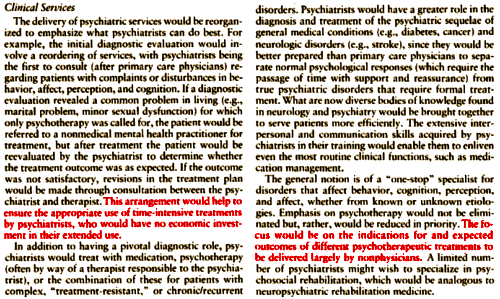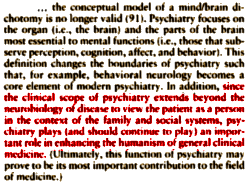by Lieberman JA and Rush AJ
Am J Psychiatry. 1996 Nov;153(11):1388-97.

Sometimes, the hardest thing to see is the thing that’s closest to you. I’ve been wondering why the people who were involved in the revolution of 1980 were always talking about what psychiatrists should or should not do – always "redefining." Why were they so insistent on negating the mind/brain dichotomy? What was the force behind saying "evidence-based" or "measurement-based" in every sentence where it could possibly be inserted? As I read through Drs. Lieberman and Rush’s commentary, I saw those parts in red and sort of had an awakening. The charge was that the psychodynamic psychiatrists and analysts inappropriately used time-intensive treatments for economic gain. It wasn’t just that other disciplines charged less, it was that the psychotherapist/psychiatrists had an economic investment in doing long term psychotherapy and took advantage of insurers and patients. My own team was the last generation of "bad guys" – what the "new psychiatry" was getting over.
 I missed that part of the story, but from the intensity of the reaction, it must’ve had some truth in it. I practiced psychotherapy in a post-3rd-party world and my fees were in the range of my counterparts in other specialties. Those who used insurance filed it themselves. Most didn’t. But that’s another story not really germane here. I expect the charge is truer than I’d like, and less true than the straw man it became. But for the moment, I’ll need to digest the fact that what happened in 1980 must’ve felt like a reform movement to its proponents. I know that in that year before I left, I felt like a pariah.
I missed that part of the story, but from the intensity of the reaction, it must’ve had some truth in it. I practiced psychotherapy in a post-3rd-party world and my fees were in the range of my counterparts in other specialties. Those who used insurance filed it themselves. Most didn’t. But that’s another story not really germane here. I expect the charge is truer than I’d like, and less true than the straw man it became. But for the moment, I’ll need to digest the fact that what happened in 1980 must’ve felt like a reform movement to its proponents. I know that in that year before I left, I felt like a pariah.
I’ve heard Insel, Lieberman, and others say things about the humanism of the psychiatric view of people [in red above right], and wondered how in the clinical neuroscience world of modern psychiatry, those skills might be developed. I agree that it’s an important contribution, but it doesn’t just come with the title. It’s learned by working closely with patients and not by writing prescriptions. I presume that’s part of training these days, at least I hope so.
But back to the main thread of this post. The psychotherapists/psychiatrists were apparently seen like we now view many of the neurobiologists – as in it for the money – recommending long term therapy to pad their salaries. I guess it’s an "eye for an eye world".
Your reflections today remind me of the general perception in the 1970s that too many patients were locked into interminable psychoanalytic treatments, under the prevailing theory with all of its self-justifying Catch-22 provisions. There was always a reason to keep going, and the elephant in the room often was the analyst’s unconscious conflict of interest.
At the institutional level, when I joined the faculty at U. Michigan in Ann Arbor in 1973 I took responsibility, with George Curtis, for a 26-bed adult inpatient unit where the average length of stay was 18 months. The unit advertised itself as an adult psychoanalytic program, but it produced no research of any kind to advance the field. In that same era, the length of stay in the children’s inpatient units was over 4 years. In short order George and I got the LOS on our service down to around 6-7 weeks, which allowed us to get to know the patients, to perform a supervised withdrawal of their previous, ineffective, drug treatments, to obtain a comprehensive diagnostic assessment, and to plan a new course of treatment with careful discharge planning. At the same time, we were able to conduct meaningful clinical research. By today’s standards, however, even a 6-week LOS would be considered scandalous.
This sort of thing is the background to Gerald Klerman’s advocacy of DSM-III from his position within ADAMHA and NIMH. Spitzer got the job of seeing through the production of DSM-III, but Klerman more than anyone else was the champion of the whole idea, and the administrative objectives really were more important than any scientific objectives.
Are patients any better off in this post DSM-III era, which has spawned much activity but little incisive scientific or clinical progress, as you have described so well on this site? Did TMAP or the STAR*D algorithms deliver improved outcomes? Were they taken up avidly by grateful clinicians? Are today’s drugs, touted as the products of translational discoveries, superior to the earlier agents? We all know the answers to these questions. So much for the vaunted ‘redefinition’ of psychiatry.
But I don’t see it so much as an ‘eye for an eye’ world. It’s more like ‘In the country of the blind the one-eyed man is king.’
Any insight on those days would be appreciated. I’m not kidding about having missed that part of the story. When I arrived on the scene as a resident in 1974, Jimmy Carter had been governor and converted Georgia’s few such places into state hospital units – for short stay “stabilization.” Mine was the era when beds evaporated daily and the definition of “stabilized” seemed more a function of space and time than any clinical parameter. I recall reading literature from the inpatient hospitals of old in musty books that said things like, “in the fourth year…” and wondered where such places had ever been.
I can see that the reform was long overdue. This story must be common – by the time change arrives, things have deteriorated to the point where anything else looks great, and the cry of “no more of that!” carries people for quite a distance. I think Atlanta was more parochial and the long term hospitalizations were more custodial than psychoanalytic. Our State hospital in Milledgeville was touted as the largest in the world – a snake pit kind of place. From the few times I saw it, it wasn’t much better than life under the bridges. So I saw the reform part as “deinstitutionalization,” and was less aware of the abuses of long term analytic treatment. There were only about 10 or 15 analysts in the State, so we commuted every Monday to New York for classes and supervision. I guess the South, at least in Georgia, missed the analyst on every block syndrome – though I saw it in Manhattan on those interminable trips.
‘In the country of the blind the one-eyed man is king.’
Great saying! I wish Insel was at least a one-eyed man…